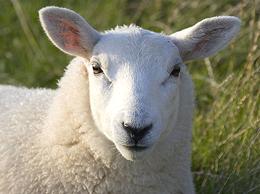
SAFARI
Users
General & History
Sheep and goats were probably the first animals to be domesticated, about 12,000 years ago. Their small size and tendency to flock made it possible to fence them in and conduct a selective breeding program to reduce wild traits. Originally sheep were raised for meat, milk and skins, but around 8000 years ago they began to be breed for wool.
Lamb consumption in the United States is rather low, averaging around 1 pound per person per year. Some Christian, Jewish and Muslim groups eat lamb at certain holidays. Most is purchased by Muslims, followed by Greeks, Jews and Hispanics, nearly all on the East and West coasts. Lamb, as sold, is expensive here, and by time you remove the bones and all that fat, it is quite expensive.
In the United States, three sheep designations are used.
Lamb:
A sheep one year old or less. Inspectors determine age in live sheep from the teeth, In carcasses by the joints in the front shank and the ribs. Lamb accounts for most of the sheep meat sold in the US.Yearling Lamb:
A sheep older than one year and younger than two years. This is roughly equivalent to the term Hogget used in Canada, UK, Australia and New Zealand.Mutton:
A sheep older than two years. Mutton is very rare in the US, but can be found in some ethnic markets, particularly those serving a Philippine community. Mutton has a stronger taste than lamb. Most mutton is shipped here from New Zealand and Australia.
The USDA grades quality of lamb meat on a scale depending on palatability. The grades are:
Prime:
This meat from fatter sheep accounts for less than 10% of US production.Choice:
This grade accounts for about 90% of all US lamb production.Good & Utility:
These lower grades are very rare in US lamb production.
Who Eat's Sheep & Goat?
Jews
are free to eat lamb and goat provided it has been ritually slaughtered. In the religion's land of origin, the Middle East, lamb dominates because there is no lush grazing land for cattle, and pig is forbidden, so lamb / mutton is important to Jewish culture worldwide.Islam
adopted much of it's dietary law from Judaism, and is also predominantly a religion of less fertile regions. While beef is not forbidden, it can't be economically raised in most Islamic regions, so lamb / mutton is the meat of choice, and goat is allowed.Southeast Asia:
Muslim areas including the far south of Thailand, most of Malaysia and Indonesia, favor lamb, but it's more expensive in tropical climates, so buffalo is more popular. Non-Muslims prefer pig, which is in good supply and much less costly.India:
In areas of India that were under Muslim occupation for some time, such as the Punjab and Hyderabad, lamb is preferred, but goat is the most common meat in India. Recipes can confuse you because during the Raj the British were pleased to call goat "mutton" to make it taste better.Christians
, largely recruited from the Pagans, brought a whole lot of Paganism with them. Rejecting the religious prohibitions of Judaism they eat whatever is economical in the region where they live. In the Middle East and other less fertile areas that will be sheep and goat, but cow and pig are preferred where economical.North Americans
are predominantly Christians, Pagans, Atheists or "Mix and Match". Lamb is not that popular here because it's too expensive compared to cow and pig, and some don't like the smell while it's cooking.



